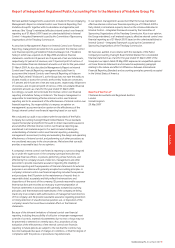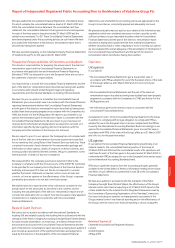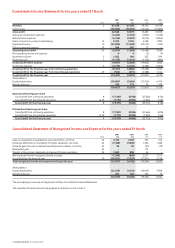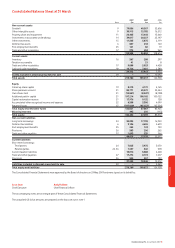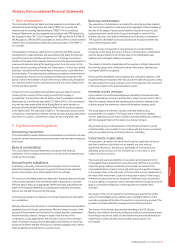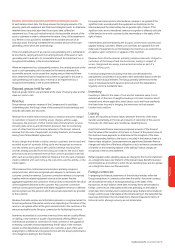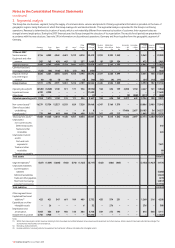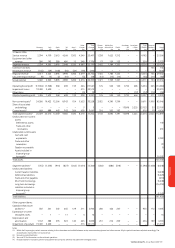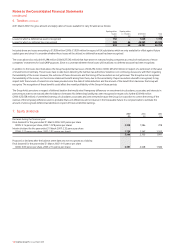Vodafone 2007 Annual Report Download - page 100
Download and view the complete annual report
Please find page 100 of the 2007 Vodafone annual report below. You can navigate through the pages in the report by either clicking on the pages listed below, or by using the keyword search tool below to find specific information within the annual report.98 Vodafone Group Plc Annual Report 2007
Notes to the Consolidated Financial Statements
continued
2. Significant accounting policies continued
Changes in the fair value of monetary securities denominated in foreign
currency classified as available for sale are analysed between translation
differences and other changes in the carrying amount of the security.
Translation differences are recognised in the income statement and other
changes in carrying amount are recognised in equity.
Translation differences on non-monetary financial assets and liabilities are
reported as part of the fair value gain or loss. Translation differences on non-
monetary financial assets, such as investments in equity securities classified
as available for sale, are included in the fair value reserve in equity.
For the purpose of presenting Consolidated Financial Statements, the
assets and liabilities of entities with a functional currency other than
sterling are expressed in sterling using exchange rates prevailing on the
balance sheet date. Income and expense items and cash flows are
translated at the average exchange rates for the period and exchange
differences arising are recognised directly in equity. Such translation
differences are recognised in the income statement in the period in which
a foreign operation is disposed of.
Goodwill and fair value adjustments arising on the acquisition of a foreign
operation are treated as assets and liabilities of the foreign operation and
translated accordingly.
In respect of all foreign operations, any exchange differences that have
arisen before 1 April 2004, the date of transition to IFRS, are deemed to be
nil and will be excluded from the determination of any subsequent profit or
loss on disposal.
Borrowing costs
All borrowing costs are recognised in the income statement in the period in
which they are incurred.
Post employment benefits
For defined benefit retirement plans, the difference between the fair value of
the plan assets and the present value of the plan liabilities is recognised as an
asset or liability on the balance sheet. During the year ended 31 March 2006,
the Group early adopted the amendment to IAS 19, “Employee Benefits”,
issued by the IASB on 16 December 2004 and applied it from 1 April 2004.
Accordingly, actuarial gains and losses are taken to the statement of
recognised income and expense. For this purpose, actuarial gains and losses
comprise both the effects of changes in actuarial assumptions and
experience adjustments arising because of differences between the previous
actuarial assumptions and what has actually occurred.
Other movements in the net surplus or deficit are recognised in the income
statement, including the current service cost, any past service cost and the
effect of any curtailment or settlements. The interest cost less the expected
return on assets is also charged to the income statement. The amount
charged to the income statement in respect of these plans is included within
operating costs or in the Group’s share of the results of equity accounted
operations as appropriate.
The values attributed to plan liabilities are assessed in accordance with the
advice of independent qualified actuaries.
The Group’s contributions to defined contribution pension plans are charged
to the income statement as they fall due.
Cumulative actuarial gains and losses as at 1 April 2004, the date of transition
to IFRS, have been recognised in the balance sheet.
Taxation
Income tax expense represents the sum of the current tax payable and
deferred tax.
Current tax payable or recoverable is based on taxable profit for the year.
Taxable profit differs from profit as reported in the income statement because
some items of income or expense are taxable or deductible in different years
or may never be taxable or deductible. The Group’s liability for current tax is
calculated using UK and foreign tax rates and laws that have been enacted or
substantively enacted by the balance sheet date.
Deferred tax is the tax expected to be payable or recoverable in the future
arising from temporary differences between the carrying amounts of assets
and liabilities in the financial statements and the corresponding tax bases
used in the computation of taxable profit. It is accounted for using the
balance sheet liability method. Deferred tax liabilities are generally
recognised for all taxable temporary differences and deferred tax assets are
recognised to the extent that it is probable that taxable profits will be
available against which deductible temporary differences can be utilised.
Such assets and liabilities are not recognised if the temporary difference
arises from goodwill or from the initial recognition (other than in a business
combination) of assets and liabilities in a transaction that affects neither the
taxable profit nor the accounting profit.
Deferred tax liabilities are recognised for taxable temporary differences arising
on investments in subsidiaries and associates, and interests in joint ventures,
except where the Group is able to control the reversal of the temporary
difference and it is probable that the temporary difference will not reverse in
the foreseeable future.
The carrying amount of deferred tax assets is reviewed at each balance
sheet date and reduced to the extent that it is no longer probable that
sufficient taxable profits will be available to allow all or part of the asset to
be recovered.
Deferred tax is calculated at the tax rates that are expected to apply in the
period when the liability is settled or the asset realised, based on tax rates
that have been enacted or substantively enacted by the balance sheet date.
Tax assets and liabilities are offset when there is a legally enforceable right to
set off current tax assets against current tax liabilities and when they either
relate to income taxes levied by the same taxation authority on either the
same taxable entity or on different taxable entities which intend to settle the
current tax assets and liabilities on a net basis.
Tax is charged or credited to the income statement, except when it relates to
items charged or credited directly to equity, in which case the tax is also
recognised directly in equity.
Financial instruments
Financial assets and financial liabilities, in respect of financial instruments, are
recognised on the Group’s balance sheet when the Group becomes a party to
the contractual provisions of the instrument.
The Group has applied the requirements of IFRS to financial instruments for
all periods presented and has not taken advantage of any exemptions
available to first time adopters of IFRS in this respect. During the year ended
31 March 2006, the Group early adopted IFRS 7, “Financial Instruments:
Disclosures”, amendments to IAS 39, “Financial Instruments: Recognition and
Measurement” and IFRS 4, “Insurance Contracts”, regarding “Financial
Guarantee Contracts” and amendments to IAS 39 regarding “The Fair Value
Option” and “Cash Flow Hedge Accounting of Forecast Intragroup
Transactions” and applied them from 1 April 2004.
Trade receivables
Trade receivables do not carry any interest and are stated at their nominal
value as reduced by appropriate allowances for estimated irrecoverable
amounts. Estimated irrecoverable amounts are based on the ageing of the
receivable balances and historical experience. Individual trade receivables are
written off when management deems them not to be collectible.



